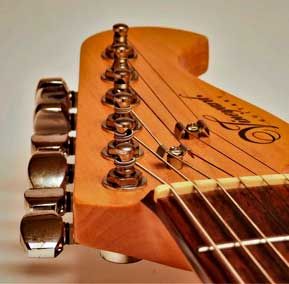Chords with lyrics
"AUTUMN LEAVES" (Joseph Kosma, 1947--"jazz standard") =============== -- chord chart "arrangement" by tcg, 198?, 1994 -- 4/4 // key ofEm/GEm/G // Allegro (pretty fast) [the way _I_ played it, at least!-- just to piss off Roger Williams...] -- form: 32-bar--||: A(8)-A(8)-B(8)-C(8) :|| -- the lyrics? believe me, you DON'T want to know! . . . -- each chord symbol = / / / / [straight fours: "chunk"-"chunk"-"chunk"-"chunk"] -- chords voiced for fingerstyle; may have to alter voicings for plectrum (especially Em...) A:
Am7Am7
Am6Am6 GM7 GM6 5-55(5)- 5-45(5)- 3-44(3)- 3-24(3)-
Am7Am7 Co7*
E minorEm
E minorEm [hold for 4] 5-55(5)- -3(4)24- 0-545- 0-545- [repeat
A augmentedA] B:
B7B7
B7B7
E minorEm
E minorEm -2424- -2424- 0-545- 0-545-
D7D7
D7D7 GM7 GM7 -5453- -5453- 3-443- 3-443- C:
Am7Am7
B7B7
E minorEm
E minorEm 5-555- -2424- 0-545- 0-545-
Am7Am7
B7B7
E minorEm
E minorEm [hold for 4] 5-555- -2424- 0-545- 0-545- * Co7 is a substitute for the
B7B7 chord in the "sheet music"; feel free to interchange Co7 &
B7B7 in tune [Co7 = B7b9(no root)]. In fact, the chords above can be viewed as a simple example of jazz substitutions--
A augmentedA section, "sheet music":
A minorAm
D7D7
G+G
G+G
A minorAm
B7B7
E minorEm
E minorEm " " "jazz chords":
Am7Am7
Am6Am6 GM7 GM6
Am7Am7 Co7
E minorEm
E minorEm --the WHY's: 1) Am-->Am7: in most cases, you can play a m7 for a minor to get a "jazzier" sound (Santana & Steely Dan did it all the time--likewise, in this tune, you could change all the Em's to Em7's...). Another common jazz substitution "line" for the plain minor chord could also be incorporated into this song: instead of
E minorEm Em, try Em(//) Em(M7) (//) Em7(//)
Em6Em6 (//). 2) D7-->Am6: for a V7 chord in a major tonality (here, D7, in
G+G major), you can substitute the V9 (D7->D9); in addition, D9(no root)=Am6 [V9(no root)=ii6]; therefore,
D7D7 becomes...Am6!, which follows nicely, voice-leading-wise after the Am7.... ("IT's not MAG-ic....") 3) G-->GM7-M6: for the I (major tonic or "key") chord, especially long stretches thereof, the M7, M6, or both! can be played in lieu of the boring plain major chord (though the M7 & M6 would sound pretty weird in a country or folk progression!).... 4) B7-->Co7: see *note above; indeed, most diminished seventh chords you'll see can be explained as substitutes for some dominant seventh-type chord.... LEAD notes: I'd tab out the schmaltzy melody, but the reason this song is still being recorded by jazz people to this day is that it's a fun tune to improvise over (and by the way, only the Lord knows why anyone would still want to sing the corny words!). Since this song doesn't modulate (unless you count GM<->Em, but not really) it's a lot easier to jam over than most "jazz standards." In fact, you only need TWO scales: 1.
E MajorE natural (aeolian) minor (=G major!) scale: e-f#-g-a-b-c-d-e --this'll fit all the chords except the
B7B7 & Co7.... 2.
E MajorE harmonic minor scale: e-f#-g-a-b-c-*d#*-e --this'll fit over the
B7B7 & Co7 chords: notice that the only difference from the first scale is the d#--in fact, it's actually easier to just think "d# instead of d" when you come to these chords than to worry about "harmonic instead of natural minor! oh, no!...." {3. For a little spice, try a diminished 7th arpeggio over the Co7 &
B7B7 chords: c-d#-f#-a (true, these tones are in the harmonic minor scale given above--just a slightly different approach): ______ --try playin' from low to high and back, then experiment I ||1||| on your own--right, just every three frets in any |||1|1 direction!... |3|||| ||4|3| |||4|4 |||||| --Now lay down the rhythm track, and go fer it-- FINALLY, the "sound" of these chords (and associated scales) does take a lot of getting used to--even after you get the rather difficult fingerings down (took me months), there's still the matter of acclimating your ears to actually _liking_ the sound of, say, a M6/9b5 chord (took me years!). But if the plain old G-C-D stuff is gettin' yu' down, and you also realize you'll never be a great speed-metal lead picker--well, this is one logical direction of development. . . . Oh, a M6/9b5? :: CM6/9b5: - 3 2 2 3 2 . "Beautiful-ugly," ain't it?! | --:--tcg )


